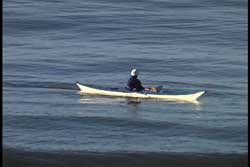
Surf A Wave And Get Off
By Wayne Horodowich
As a member of the US Surf Kayaking Team I had the honor and privilege to compete in the world championships in Scotland in 1991 and in the US in 1993. The surfing competitions were fun and exciting. The camaraderie amongst the contestants is a memory I will never forget. We paddled hard all day and some had the stamina to party all night. I freely admit I would not have won any contests in the party category. I just enjoyed the company of my friends who I hoped I would beat the next day. I mention this because I think about that every time I get on a wave and take a simple ride. I think about the giant waves in Thurso Scotland. I think about the "room of doom" (the caves under the cliffs at Santa Cruz, CA) where you hoped you would never find yourself, but eventually get caught there. A simple ride is never that, because of all my surfing memories. I can't even begin this article on riding a wave without these great memories flooding into my consciousness. Time to focus!
When I think about riding waves I usually think of myself in a competition kayak. These smaller and more maneuverable kayaks are made for riding waves. Their design allows for turns and the ones used now are designed for spins. Unfortunately standard sea kayaks are not designed for high performance surfing. You can surf a wave, but fancy maneuvers are difficult or impossible in a long boat designed for tracking straight. You should keep that in mind when you plan to go surfing. Pick a craft suitable for the desired experience.
For this article I will be discussing the technique as if you are in a standard sea going kayak. It is important to realize that once a sea kayak starts carving a turn on a wave it takes a lot to turn it back the other way, if you can even do it. I have broken two paddles in my career trying to force a sea kayak out of a turn. I would like to say I hand rolled up after the capsize, but I would be telling a tall tale. Yes, I swam and had to swim my kayak ashore. When I was in my sea kayak, I began to accept the fact that taking a quick ride and getting off the wave would be the best use of my energy, if I wanted to catch a lot of waves for the time I had on the water. If I wanted to work harder, I would ride the wave and then side surf the whitewater wave to shore. I say work harder, because I would have to paddle out through breaking waves to get my next wave. See USK article, "Surf A Wave and Side Surf Combo." Let's look at the ride and get off strategy for getting more rides while you are out there.

As you wait for your wave to come in, I hope you have chosen a location suitable for the boat you are using and your skill level. I also hope you picked a location where you will not run into anyone or anything. Proper clothing, PFD and a helmet are necessities when surfing. Keep in mind that a 16' kayak, surfing ten boat lengths, will have covered 160 feet, which equals 53.3 yards, which is more than half a football field. Surfing sea kayaks means you needs lots of space.
Before you paddled out, you picked the general location that will give you the best chance to catch a wave without having to work too hard. In addition, surfing an area that does not have closeout waves is desirable. A point break is the best place to find waves for riding and getting off. The only problem is that good point breaks are usually full of board surfers. I had enough problems surfing around them in my high performance kayak so my sea kayak was out of the question in popular surfing areas.
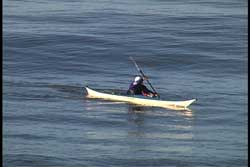
Once you have picked your wave, which is now just an oncoming swell, you start paddling forward to pick up speed. Your goal is to have the swell catch you as it begins to pitch up. If you started too soon, you will be paddling in front of the wave until it actually breaks on you or behind you.
If you start too late you, will have the wave pass under you before it pitches up enough to surf you forward. I hated those times. I would paddle for all I was worth and almost just catch the wave, but it would keep moving forward as I fell behind.
You need to keep in mind that a wave is not really pushing you forward. It is lifting your stern enough to where gravity pulls you down the wave. It feel like you are being pushed forward, but you are really being lifted. If you are in the whitewater, after the wave breaks, that moving water can push your kayak. The wave before it breaks moves you forward by lifting your kayak up and your kayak slides down the wave.
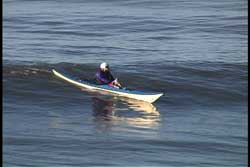
In this illustration You can see Rod's kayak being lifted up just enough to start the kayak sliding down the wave. If you already have forward momentum, as I mentioned before, you do not need as much lift to get you surfing. If you try to take off on a wave from a stand still, you need a steeper wave to get you moving. In addition, your ride will be shorter because you waited until the wave pitched up higher which is nearer it's breaking point.
If you want to ride a wave and get off, you want to start when the wave is just starting to pitch up. Again, the faster your kayak is moving the less lift you need. I usually err on the side of paddling a little longer than necessary just to make sure I have fully caught the wave.
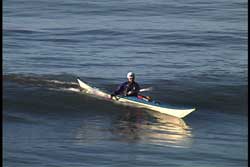
Once I am on the wave I let the wave and gravity do the work. Depending on the length of ride I am anticipating, will determine how long I can play on the wave before I need to get off before it breaks. I know where that point is, because I was watching the waves break when I was on shore and I was paying attention to my take off area, where the wave crested and then broke.
If during the ride I need to paddle to stay on a smaller wave, I do so. Otherwise, I use my paddle as a stern rudder to steer the kayak. I say steer, but it usually means keeping my kayak heading straight in, until I know I need to get off the wave. That feeling of surfing a wave on a sunny day easily makes you forget problems and worries. You are now part of nature.
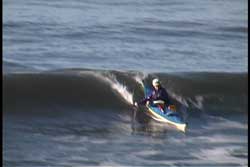
As the wave pitches up higher, you will pick up more speed, because gravity is pulling you faster down the wave. The faster you go down the wave the more you can shoot out in front of it if you are going straight. The problem being, if you are in front of the wave at the bottom of the wave, you will have the wave break on you.
When you feel the wave getting higher and your speed increases, you want to start using a low brace to turn into the wave. If you are riding a wave that has a shoulder, meaning it is breaking from one side to another (usually a refracting wave), you want to turn into the front of the wave, which means it will be breaking behind you as you turn into it.
In this illustration this wave is a right break. As you are on the wave it will break from the left moving to the right. As you look directly at the photo, Rod is moving to your left (his right). The wave will begin to break behind Rod's left shoulder.
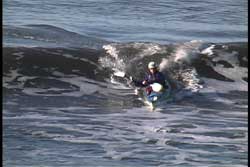
As Rod starts turning into the wave, he transitions from a low brace to a high brace. He is also lifting his left knee to help edge his kayak which aids in his turning. It also presents the correct edge for staying upright in the off chance he miscalculates his timing and the wave ends up breaking on him. He needs to be edged properly if he wants to stay upright when parallel to a breaking wave. See USK article, "Side Hit In The Surf Zone."
Using the speed provided by the wave, to turn into the wave, is how you will be able to climb up the face and get off before the wave breaks. That it why it is important not to waste that speed by surfing too far in front of the wave.
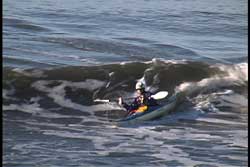
As the wave is becoming critical, you hope you have timed the break correctly. The speed you get from the wave, added to using a high brace in the face of the wave to help you climb up the face, is what you will need to get your kayak up over the peak of the wave before it breaks.
Another way of looking at this technique is thinking of it as turning into the wave and keep on turning until you are going up and over the wave. The critical factor is the speed you get from the wave. Sea kayaks are long and heavy. Their length allows them to get more speed than the high performance kayaks. That speed is your ace in the hole for getting up and over the wave. Just think about turning into the wave and keep turning until you are pointing back out to sea.
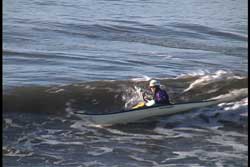
Keep in mind this is all good in theory. The only way to know how fast your kayak will go and when to turn can only be learned out on the water. Which leads me to one of my favorite quotes when teaching surf classes, "You cannot appreciate the sweet spot until you have tasted the sour spot." I have just added this saying to the USK Yakism's page.
If you have used your speed wisely, turned soon enough and correctly used your brace when needed, you should turn up the face of the wave to go over it. Don't forget, the more you edge your kayak into the wave the more turn you can get out of the kayak.
Even though Rod's goal is to get over the wave, he is in perfect set up in case the wave breaks on him. He is bracing into the wave. He is edging into the wave. If the wave breaks on him he should remain upright. It is nice when the techniques you need for one maneuver are the same for your back up plan if your maneuver doesn't work.
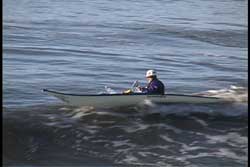
As usual Rod's timing was correct and he made it over the wave before it broke. Rod will freely admit he has missed a lot of crests in his time, but that is how he learned his timing and techniques.
Once over the crest it is not a time to stop and pat yourself on your back. You need to add to your remaining speed and sprint back out before the next wave comes in and breaks on you. Remember, you just got off a wave before it broke, which puts you right near the break zone. Another favorite quote I use in my surf lecture is, "Waves have friends and they are never far behind." Time to add this quote to the Yakism's too.
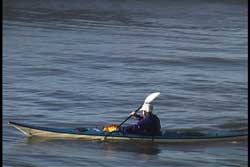
The good news in surfing a sea kayak is the speed that a sea kayak has over a high performance surf kayak. Now the length is working for you. The ability to pick up speed and make it out beyond any breaking waves is easier in our sea kayaks.
Since you were near the break zone the odds of having the next wave break on you is low, but not zero. There could be a larger wave coming in, which will break farther out so you need to be paying attention. When you paddle out, do it with purpose and take solid strokes.
The speed you gather should be more than enough to take you over any oncoming wave that has begun to pitch up. The extreme case can be one of those sneaker waves, that seems to come out of nowhere, that breaks farther out than anything you have seen all day. As always pay attention to what is coming next.
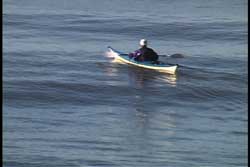
Once you are out past the breakers and in the area to catch another wave, take a moment to reflect on your last ride. Think about your timing and the feel of the ride. Take a deep breath and look around and enjoy your environment. Enjoy the reduced noise levels. Feel the water moving you. Feel the water on your hands. Watch the birds and marine life. While you do all of this you are keeping an eye out for the waves coming at you so you don't get surprised by that sneaker.
Don't forget to make any adjustments to your clothing if necessary, to drink some water or have a snack if you need energy. You have earned it. When you are ready, pick out your next wave and enjoy the ride.
When you know you are taking your last ride in for the day, you may want to take the lazy way in by riding the wave and then side surfing the whitewater after the wave breaks.
There is another reason to use the ride and get off technique. You can use it to get close to the break zone. After you get off you can turn quickly and head into shore past the break area. The next wave will catch you after it has broken, but you did get a ride and avoided the break. Then you must decide how you want to take the whitewater wave and continue to make your way to shore.
As I said at the beginning of the article, I have lots of fond memories that come gushing in whenever I ride a wave or even think about riding waves. When I am in my sea kayak I have the most fun when I spend my time riding waves and getting off before they break, because I can get more rides in a day before I get tired. When I want to carve turns and do a lot of maneuvering I use my surf kayak. This ride and get off technique can be done in any kayak, it is not reserved exclusively for sea kayaks. The huge waves we surfed in Scotland were waves we rode and got off as the wave hit the deep water of the river mouth. You did NOT want to be in those big waves when they broke. One of them snapped my teammates kayak in half. Mark was lucky the kayak split under his seat and not behind his legs. You see, more memories keep rushing in.
That last story was not meant to scare you. It is a consequence of riding very big waves. You should pick waves appropriate to your skill level. It is good to surf with friends, but remember how far your sea kayak can travel in a surf zone on a wave and keep plenty of distance between you and others in the surf zone. Most of all have a good time and make your own memories.
Pictures seen above were taken from the Award Winning USK Video "ABC'S of the Surf Zone"
© Copyright USK